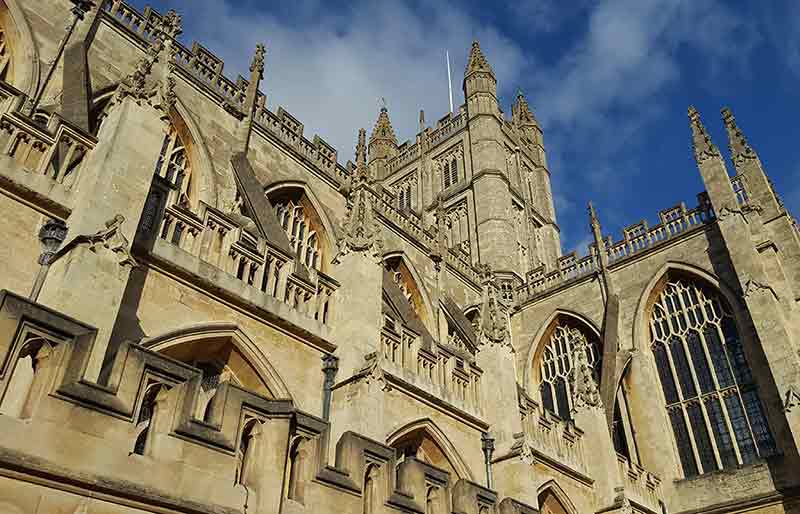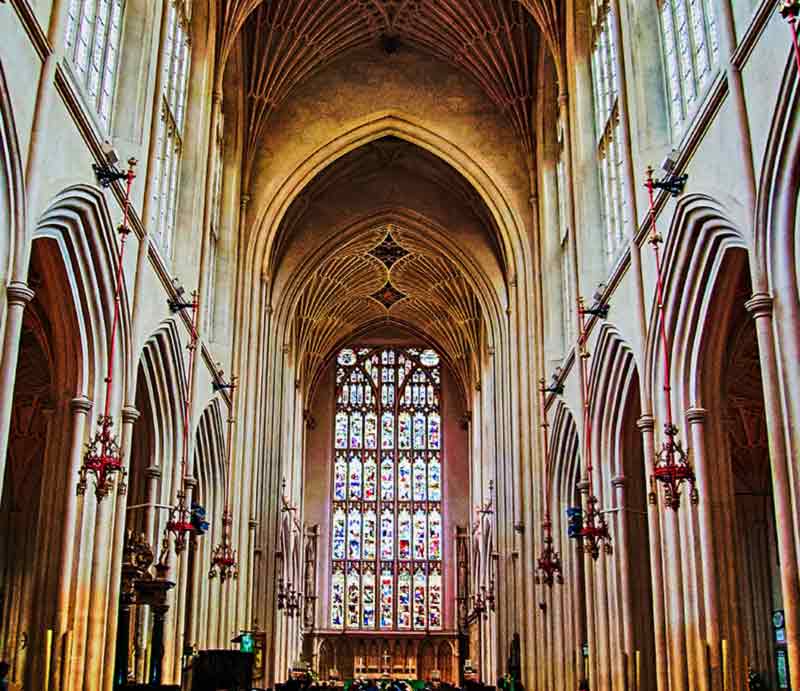The present Abbey church began its construction around 1499, inspired by a reported dream of Bishop Oliver King, who envisioned angels ascending and descending into heaven – a scene immortalized on the Abbey's western facade. This new church, one of the last great medieval cathedrals to be built in England, was still incomplete at the time of King Henry VIII's Dissolution of the Monasteries in 1539. Stripped of its valuable components and left to decay, the Abbey lay in ruins for decades until Queen Elizabeth I promoted its restoration in the late 16th century to serve as the grand parish church of Bath.
Bath Abbey

Bath Abbey, officially known as the Abbey Church of Saint Peter and Saint Paul, stands as a magnificent testament to centuries of history and architectural evolution in the heart of Bath, England. Its striking Perpendicular Gothic architecture, particularly its stunning fan vaulting and the unique "ladders of angels" on its West Front, make it one of the most recognizable and significant churches in the country.
History
The history of the site stretches back well over a thousand years, with three different churches having occupied the location since 757 AD. The earliest was an Anglo-Saxon monastery, which was later replaced by a massive Norman cathedral begun around 1090. By the late 15th century, this Norman structure had fallen into ruin.

Significant restoration work continued over the centuries, most notably in the 1860s by Sir George Gilbert Scott. Scott's contributions included replacing the nave's ancient wooden ceiling with the spectacular stone fan vaulting seen today, and opening up the interior to accommodate larger congregations. Recent projects have focused on preserving the historic fabric while also enhancing accessibility and sustainability, including an innovative underfloor heating system utilizing the city's natural thermal springs.
Beyond its architectural grandeur, Bath Abbey holds profound historical significance. It was on this very site in 973 AD that Edgar of Wessex was crowned King of all England, a ceremony that set the precedent for all subsequent coronations of English monarchs, including Elizabeth II. The Abbey also houses an extensive collection of wall and floor memorials, offering a unique glimpse into the lives of Bath's residents from the 17th to the 19th centuries, including those from the Georgian period.
Today, Bath Abbey continues to be a vibrant place of worship and a central hub for the community. Its awe-inspiring architecture, rich history, and spiritual atmosphere draw visitors from around the world, making it an essential landmark in the cultural and religious landscape of the United Kingdom.
Visitor Information
For visitors, Bath Abbey offers a wealth of experiences:
Explore the Main Abbey Floor: Wander through the magnificent nave and transepts, taking in the scale and beauty of the architecture. The fan-vaulted ceiling, particularly the original 16th-century section and the 19th-century replication, is a highlight. Look closely at the "ladders of angels" on the West Front, a unique and iconic carving.
Discover the Stained Glass Windows: The Abbey boasts impressive stained-glass windows, including the Great East Window, which tells the story of Jesus in 56 scenes, and the King Edgar Window, depicting the historic coronation that took place on this very site. The West Window illustrates stories from the first five books of the Bible.
Uncover the Ledgerstones and Memorials: The Abbey floor is comprised of 891 flat grave stones, known as ledgerstones, which have been painstakingly restored. Along with the numerous wall memorials, they offer a fascinating record of Bath's past residents, providing insights into their lives, beliefs, and societal roles from the 17th to 19th centuries. Information panels often highlight interesting names and stories.
Visit the Birde's Chantry Chapel: Built by Prior William Birde, this chapel offers a quiet space for reflection and prayer, with delicate stone carvings to admire.
Delve into the Discovery Centre: Located beneath the Abbey, this modern heritage center brings the Abbey's history to life through interactive displays, videos, and exhibits of medieval carved stone fragments and historical artifacts. It provides a deeper understanding of the building's evolution and the lives connected to it.
Take a Tower Tour: For a truly unforgettable experience, visitors can ascend the 212 steps of the Abbey's tower. These guided tours offer a unique "behind the scenes" look, allowing you to see the Abbey's clock face and bells up close, and even walk on top of the fan-vaulted ceiling. The culmination is a breathtaking panoramic view of the city of Bath and the surrounding countryside, offering a fantastic perspective on iconic landmarks like the Roman Baths and Thermae Bath Spa. Tower tours are generally suitable for ages 5 and up.
Attend a Service or Listen to the Choir: As a living church, Bath Abbey hosts regular services throughout the week, offering visitors the opportunity to experience its spiritual atmosphere and enjoy its renowned choral music.
Browse the Abbey Shop: A well-stocked shop offers a range of souvenirs, books, and gifts related to the Abbey's history and Christian themes.
Engage with Volunteers: Abbey volunteers are often on hand to share insights into the building's history, current life, and answer questions.
Utilize Audio Guides: For a more in-depth exploration, audio guides are available, offering "Highlights of the Abbey" or "Memorials and Empire" tours.
Family-Friendly Activities: Families with young children can borrow "Little Explorer backpacks" filled with fun items to aid their exploration, or follow a family trail booklet.
Whether you're interested in architecture, history, religious heritage, or simply seeking a moment of tranquility amidst the bustling city, Bath Abbey offers a rich and rewarding experience for all who step inside.
Tips for Visitors
Planning Your Visit
Check Opening Hours: As a working church, hours can change, especially around services, weddings, or special events. Always check the official Bath Abbey website for the most up-to-date visiting times, particularly on Sundays when visiting hours are typically restricted.
Best Time to Visit: To avoid the biggest crowds, try to visit early in the morning right after opening, or later in the afternoon about an hour before closing.
Location: The Abbey is centrally located, right next to the Roman Baths and Pump Room, making it easy to combine with other key Bath attractions.
Entry is by Donation: General admission is usually by suggested donation rather than a compulsory fee, which helps with the building's maintenance.
Tower Tour (Highly Recommended)
Book Ahead (or Early): Tower Tours are popular and have limited space. While you can often book at the Welcome Desk on the day, consider booking online or arriving early to secure a spot.
Be Prepared for Steps: The fully guided tour involves climbing 212 steps and is not suitable for people with mobility issues, claustrophobia, vertigo, or young children (usually 5 and under are not permitted).
Wear Sensible Shoes: Flip-flops, sandals, and heels are not allowed due to the narrow, steep, spiral staircases. Wear fully secured, sensible footwear.
The View is Worth It: The tour takes you behind the scenes, above the fan vaulting, past the bells, and up to the top for spectacular panoramic views of Bath city, including a unique vantage point over the Roman Baths.
Bags: Bags are not usually allowed up the tower, but hooks for personal belongings are typically provided in the stairwell.
General Tips
Be Respectful: The Abbey is an active place of worship. Be mindful of services, and keep noise to a minimum.
Tours: Consider taking a guided tour (which may be included with the Tower Tour ticket) or downloading an audio guide to learn more about the history and architecture.
Useful Links
Bath Abbey: Official Website (Opens in new window) Provides visitor information incuding: opening times, travel, tickets, tours, the Abbey Shop, the Discovery Museum, services, upcoming events, and accessibility. Learn about the various ways to engage with the Abbey, such as joining the choir or participating in family crafts.
Facebook: Bath Abbey (Opens in new window) Catch up on the latest photos, and news & events from the Abbey.
X: Bath Abbey (Opens in new window)
Instagram: Bath Abbey (Opens in new window)
Spotify: The Choir of Bath Abbey (Opens in new window)
Bath Abbey Tours (Opens in new window) A list of private chauffeured tours, all featuring a visit to Bath Abbey. Plus information and photos of the Abbey.
National Churches Trust: Bath Abbey (Opens in new window) Provides general information about Bath Abbey, including its historical significance, architectural features, and practical details for visitors.
Help us with content
We are eager to improve and add to the Bath Abbey content on this website. If you would like to contribute or submit a review of Bath Abbey then please email details to us.
If you have any photos of the Abbey you'd like displayed on the website then email us and we'll then reply so you can send in photos. Thank you.

